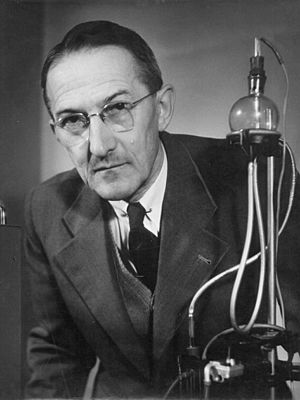Jaroslav Heyrovský facts for kids
Quick facts for kids
Jaroslav Heyrovský
|
|
|---|---|
 |
|
| Born | December 20, 1890 |
| Died | March 27, 1967 (aged 76) |
| Nationality | Czech |
| Alma mater | |
| Known for | Electroanalytical chemistry Polarography |
| Awards | |
| Scientific career | |
| Fields |
|
| Doctoral advisor | Frederick G. Donnan |
Jaroslav Heyrovský (December 20, 1890 – March 27, 1967) was a famous Czech chemist and inventor. He is best known for inventing a special scientific method called polarography. This method helps scientists understand different chemicals using electricity. Because of his amazing invention, he won the Nobel Prize in Chemistry in 1959. His main work was in a field called electroanalytical chemistry, which uses electrical measurements to study chemicals.
Contents
Life and Work
Early Life and Education
Jaroslav Heyrovský was born in Prague on December 20, 1890. He was the fifth child in his family. His father, Leopold Heyrovský, was a professor at Charles University in Prague.
Young Jaroslav loved learning. From 1909, he studied chemistry, physics, and mathematics at Charles University. Later, from 1910 to 1914, he continued his studies at University College London. There, he worked with important scientists like Frederick G. Donnan. He was very interested in how electricity and chemistry work together. This field is known as electrochemistry.
War and Further Studies
During First World War, Jaroslav worked in a military hospital. He helped as a chemist and also with X-rays. This work allowed him to continue his studies. He earned his Ph.D. degree in Prague in 1918. He also received another advanced degree (D.Sc.) from London in 1921.
University Career and Polarography
After his studies, Heyrovský started working at Charles University in Prague. He became an assistant professor in 1922. By 1926, he became the university's first Professor of Physical Chemistry.
In 1922, Heyrovský made his most important invention: the polarographic method. He spent the rest of his scientific career developing this new area of electrochemistry. He taught many students who also became experts in polarography. In 1950, Heyrovský became the Director of the new Polarographic Institute. This institute later became part of the Czechoslovak Academy of Sciences in 1952.
Family Life
In 1926, Professor Heyrovský married Marie Koranová. They had two children, a daughter named Jitka and a son named Michael.
Jaroslav Heyrovský passed away on March 27, 1967. He was buried in the Vyšehrad cemetery in Prague.
Honors and Legacy

Many universities and scientific groups honored Heyrovský for his work. He became a Fellow of University College, London, in 1927. He also received honorary doctorates from several universities, including Dresden (1955), Warsaw (1956), Aix-Marseille (1959), and Paris (1960).
He was made an honorary member of many important scientific groups around the world. These included the American Academy of Arts and Sciences (1933) and the Royal Society (1965). He also held leadership roles, like Vice-President of the International Union of Physics from 1951 to 1957.
In his home country, Czechoslovakia, Heyrovský received the State Prize in 1951. He was also given the Order of the Czechoslovak Republic in 1955.
Heyrovský traveled to many countries to give talks about polarography. He lectured in the United States (1933), the USSR (1934), England (1946), Sweden (1947), China (1958), and Egypt (1960 and 1961).
To honor his contributions to science, a crater on the Moon was named after him. It is called Heyrovský.

